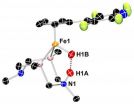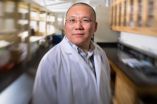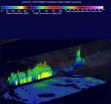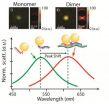(Press-News.org) RICHLAND, Wash. -- Like a hungry diner ripping open a dinner roll, a fuel cell catalyst that converts hydrogen into electricity must tear open a hydrogen molecule. Now researchers have captured a view of such a catalyst holding onto the two halves of its hydrogen feast. The view confirms previous hypotheses and provides insight into how to make the catalyst work better for alternative energy uses.
This study is the first time scientists have shown precisely where the hydrogen halves end up in the structure of a molecular catalyst that breaks down hydrogen, the team reported online April 22 in Angewandte Chemie International Edition. The design of this catalyst was inspired by the innards of a natural protein called a hydrogenase enzyme.
"The catalyst shows us what likely happens in the natural hydrogenase system," said Morris Bullock of the Department of Energy's Pacific Northwest National Laboratory. "The catalyst is where the action is, but the natural enzyme has a huge protein surrounding the catalytic site. It would be hard to see what we have seen with our catalyst because of the complexity of the protein."
Ironing Out Expense
Hydrogen-powered fuel cells offer an alternative to burning fossil fuels, which generates greenhouse gases. Molecular hydrogen -- two hydrogen atoms linked by an energy-rich chemical bond -- feeds a fuel cell. Generating electricity through chemical reactions, the fuel cell spits out water and power.
If renewable power is used to store energy in molecular hydrogen, these fuel cells can be carbon-neutral. But fuel cells aren't cheap enough for everyday use.
To make fuel cells less expensive, researchers turned to natural hydrogenase enzymes for inspiration. These enzymes break hydrogen for energy in the same way a fuel cell would. But while conventional fuel cell catalysts require expensive platinum, natural enzymes use cheap iron or nickel at their core.
Researchers have been designing catalysts inspired by hydrogenase cores and testing them. In this work, an important step in breaking a hydrogen molecule so the bond's energy can be captured as electricity is to break the bond unevenly. Instead of producing two equal hydrogen atoms, this catalyst must produce a positively charged proton and a negatively charged hydride.
The physical shape of a catalyst – along with electrochemical information -- can reveal how it does that. So far, scientists have determined the overall structure of catalysts with cheap metals using X-ray crystallography, but hydrogen atoms can't be located accurately using X-rays. Based on chemistry and X-ray methods, researchers have a best guess for the position of hydrogen atoms, but imagination is no substitute for reality.
Bullock, Tianbiao "Leo" Liu and their colleagues at the Center for Molecular Electrocatalysis at PNNL, one of DOE's Energy Frontier Research Centers, collaborated with scientists at the Spallation Neutron Source at Oak Ridge National Laboratory in Tennessee to find the lurking proton and hydride. Using a beam of neutrons like a flashlight allows researchers to pinpoint the nucleus of atoms that form the backbone architecture of their iron-based catalyst.
Bonding Jamboree
To use their iron-based catalyst in neutron crystallography, the team had to modify it chemically so it would react with the hydrogen molecule in just the right way. Neutron crystallography also requires larger crystals as starting material compared to X-ray crystallography.
"We were designing a molecule that represented an intermediate in the chemical reaction, and it required special experimental techniques," Liu said. "It took more than six months to find the right conditions to grow large single crystals suitable for neutron diffraction. And another six months to pinpoint the position of the split H2 molecule."
Crystallizing their catalyst of interest into a nugget almost 40 times the size needed for X-rays, the team succeeded in determining the structure of the iron-based catalyst.
The structure, they found, confirmed theories based on chemical analyses. For example, the barbell-shaped hydrogen molecule snuggles into the catalyst core. On being split, the negatively charged hydride attaches to the iron at the center of the catalyst; meanwhile, the positively charged proton attaches to a nitrogen atom across the catalytic core. The researchers expected this set-up, but no one had accurately characterized it in an actual structure before.
In this form, the hydride and proton form a type of bond uncommonly seen by scientists -- a dihydrogen bond. The energy-rich chemical bond between two hydrogen atoms in a molecule is called a covalent bond and is very strong. Another bond called a "hydrogen bond" is a weak one formed between a slightly positive hydrogen and another, slightly negative atom.
Hydrogen bonds stabilize the structure of molecules by tacking down chains as they fold over within a molecule or between two independent molecules. Hydrogen bonds are also key to water surface tension, ice's ability to float and even a snowflake's shape.
The dihydrogen bond seen in the structure is much stronger than a single hydrogen bond. Measuring the distance between atoms reveals how tight the bond is. The team found that the dihydrogen bond was much shorter than typical hydrogen bonds but longer than typical covalent bonds. In fact, the dihydrogen bond is the shortest of its type so far identified, the researchers report.
This unusually strong dihydrogen bond likely plays into how well the catalyst balances tearing the hydrogen molecule apart and putting it back together. This balance allows the catalyst to work efficiently.
"We're not too far from acceptable with its efficiency," said Bullock. "Now we just want to make it a little more efficient and faster."
INFORMATION:
This work was supported by the Department of Energy Office of Science.
Reference: Tianbiao Liu, XiaopingWang, Christina Hoffmann, Daniel L. DuBois, and R. Morris Bullock. Heterolytic Cleavage of Hydrogen by an Iron Hydrogenase Model Investigated by Neutron Diffraction, Angewandte Chemie International Edition, April 22, 2014, doi: 10.1002/anie.201402090. (http://onlinelibrary.wiley.com/doi/10.1002/anie.201402090/abstract;jsessionid=67DB1345F830D4C336128F1AFF2219AD.f02t03)
The Department of Energy's Office of Science is the single largest supporter of basic research in the physical sciences in the United States and is working to address some of the most pressing challenges of our time.
The Spallation Neutron Source at Oak Ridge National Laboratory is a one-of-a-kind research facility that provides the most intense pulsed neutron beams in the world for scientific research and industrial development. SNS provides state-of-the-art experiment stations for researchers in physics, chemistry, materials science, and biology. For more information, please visit http://neutrons.ornl.gov/facilities/SNS/.
Interdisciplinary teams at Pacific Northwest National Laboratory address many of America's most pressing issues in energy, the environment and national security through advances in basic and applied science. PNNL employs 4,500 staff, has an annual budget of nearly $1 billion, and has been managed for the U.S. Department of Energy by Ohio-based Battelle since the laboratory's inception in 1965. For more, visit the PNNL's News Center, or follow PNNL on Facebook, LinkedIn and Twitter.
Halving hydrogen
First view of nature-inspired catalyst after ripping hydrogen apart provides insights for better, cheaper fuel cells
2014-04-23
ELSE PRESS RELEASES FROM THIS DATE:
Increased infrastructure required for effective oil spill response in US Arctic
2014-04-23
WASHINGTON – A changing climate is increasing the accessibility of U.S. Arctic waters to commercial activities such as shipping, oil and gas development, and tourism, raising concern about the risk of oil spills. A new report from the National Research Council says that a full suite of proven oil response tools is needed to address potential oil spills in U.S. Arctic waters, but not all of them are readily available. While much is known about both oil behavior and response technologies in ice-covered environments, there are areas where additional research would enable ...
On the defensive
2014-04-23
People diagnosed with Huntington's disease, most in their mid-thirties and forties, face a devastating prognosis: complete mental, physical, and behavioral decline within two decades. "Mutant" protein clusters, long blamed for the progression of the genetic disease, have been the primary focus of therapies in development by pharmaceutical companies. But according to new research from Prof. Gerardo Lederkremer and Dr. Julia Leitman of Tel Aviv University's Department of Cell Research and Immunology, in collaboration with Prof. Ulrich Hartl of the Max Planck Institute for ...
ASTRO issues guideline on the role of postoperative radiation therapy for endometrial cancer
2014-04-23
Fairfax, Va., April 23, 2014— The American Society for Radiation Oncology (ASTRO) has issued a new guideline, "The Role of Postoperative Radiation Therapy for Endometrial Cancer: An ASTRO Evidence-Based Guideline," that details the use of adjuvant radiation therapy in the treatment of endometrial cancer. The guideline's executive summary is published in the May-June 2014 issue of Practical Radiation Oncology (PRO), the official clinical practice journal of ASTRO. The full-length guideline is available as an open-access article online at http://www.practicalradonc.org.
ASTRO's ...
Conservation priorities released for several protected areas along US-Mexico border
2014-04-23
This news release is available in French and Spanish.
Montreal, 23 April 2014—Today, the CEC released its Conservation Assessment for the Big Bend-Río Bravo Region: A Binational Collaborative Approach to Conservation, which identifies 29 priority conservation areas in a region straddling the United States-Mexico border that includes 11 different protected areas in the states of Texas, Coahuila, and Chihuahua. This region features unique, highly diverse arid and semi-arid habitats inhabited by rare and endangered plants and animals, and provides a vital migratory ...
Novel compound halts cocaine addiction and relapse behaviors
2014-04-23
BUFFALO, N.Y. – A novel compound that targets an important brain receptor has a dramatic effect against a host of cocaine addiction behaviors, including relapse behavior, a University at Buffalo animal study has found.
The research provides strong evidence that this may be a novel lead compound for treating cocaine addiction, for which no effective medications exist.
The UB research was published as an online preview article in Neuropsychopharmacology last week.
In the study, the compound, RO5263397, severely blunted a broad range of cocaine addiction behaviors.
"This ...
NASA sees last vestiges of Tropical Depression Jack
2014-04-23
Tropical Cyclone Jack had weakened to a tropical depression when NASA and JAXA's Tropical Rainfall Measuring Mission (TRMM) satellite passed above on April 22, 2014 at 1120 UTC/7:20 a.m. EDT.
At that time, TRMM found that Jack was devoid of almost all rainfall near the tropical cyclone's center. Outside the center was a different story, however. That's where TRMM's precipitation radar instrument found rain falling at a rate of over 130mm/hr (about 5.1 inches) in a band of thunderstorms that stretched from east of Jack's center to the south. Some of the thunderstorms even ...
EARTH Magazine: Faking quakes at full scale
2014-04-23
Alexandria, Va. – On a muggy day in mid-July 2009, a lone seven-story condominium complex northwest of Kobe, Japan, was violently shaken by an earthquake. Onlookers watched the 23-unit, wood-frame tower sway and bounce while, inside the building, furniture toppled and plates clattered to the floor. No one was hurt during the highly localized event and there was only minimal damage, in part because the building's wooden skeleton had been augmented to better resist earthquake shaking, but also because the whole event — from the seismicity to the partially furnished building ...
Some astronauts at risk for cognitive impairment, animal studies suggest
2014-04-23
Johns Hopkins scientists report that rats exposed to high-energy particles, simulating conditions astronauts would face on a long-term deep space mission, show lapses in attention and slower reaction times, even when the radiation exposure is in extremely low dose ranges.
The cognitive impairments — which affected a large subset, but far from all, of the animals — appear to be linked to protein changes in the brain, the scientists say. The findings, if found to hold true in humans, suggest it may be possible to develop a biological marker to predict sensitivity to radiation's ...
Gold nanoparticles help target, quantify breast cancer segments in a living cell
2014-04-23
WEST LAFAYETTE, Ind. - Purdue University researchers have developed a way to detect and measure cancer levels in a living cell by using tiny gold particles with tails of synthetic DNA.
A team led by Joseph Irudayaraj, professor of agricultural and biological engineering, used gold nanoparticles to target and bind to fragments of genetic material known as BRCA1 messenger RNA splice variants, which can indicate the presence and stage of breast cancer. The number of these mRNA splice variants in a cell can be determined by examining the specific signal that light produces ...
Study identifies enzymes that help fix cancer-causing DNA defects
2014-04-23
Purdue University researchers have identified an important enzyme pathway that helps prevent new cells from receiving too many or too few chromosomes, a condition that has been directly linked to cancer and other diseases.
Mark Hall, associate professor of biochemistry, found that near the end of cell division, the enzyme Cdc14 activates Yen1, an enzyme that ensures any breaks in DNA are fully repaired before the parent cell distributes copies of the genome to daughter cells. This process helps safeguard against some of the most devastating genome errors, including the ...
LAST 30 PRESS RELEASES:
Groundbreaking discovery turns household plastic recycling into anti-cancer medication
Blocking a key inflammatory pathway improves liver structure and vascular function in cirrhosis, study finds
Continuous spread: Raccoon roundworm detected in nine European countries
HKUST Engineering researchers developed a novel photodetector to enhance the performance of on-chip light monitoring
Strategic river sensors could have forewarned of Texas Camp flood disaster
Drone sampling of whale breath reveals first evidence of potentially deadly virus in Arctic
Roman soldiers defending Hadrian’s Wall infected by parasites, study finds
Pinochet’s prisoners were tormented with music but still found solace in it, a new book reveals
Fertility remains high in rural Tanzania despite access to family planning
AI-assisted device can improve autism care access
Kinetic careers
Uncovering how parasitic plants avoid attacking themselves to improve crop resistance
Nanoparticle vaccine strategy could protect against Ebola and other deadly filoviruses
Study finds brain care score can predict risk of stroke across racial groups
Key lung immune cells can intensify allergic reactions
Do hormones explain why women experience more gut pain?
New materials conduct ions in solids as easily as in liquids
Breakthrough of the Year: Renewable energy begins to eclipse fossil fuel-based sources
LLM use is reshaping scientific enterprise by increasing output, reducing quality and more
Introducing LightGen, a chip for ultra-fast, ultra-efficient generative AI
Astronomers see fireworks from violent collisions around nearby star
ACC/AHA issue new guideline on managing congenital heart disease in adults
Cosmic crash caught on camera
Is talented youth nurtured the wrong way? New study shows: top performers develop differently than assumed
Ants: An untapped resource in the development of antibiotics?
Archaeologists use AI to create prehistoric video game
Mitochondria migrate toward the cell membrane in response to high glucose levels
Tiny viral switch offers hope against drug-resistant bacteria
Most parents aware of early peanut introduction guidelines, but confused about details
HPV vaccine can protect against severe lesions of the vulva and vagina
[Press-News.org] Halving hydrogenFirst view of nature-inspired catalyst after ripping hydrogen apart provides insights for better, cheaper fuel cells





